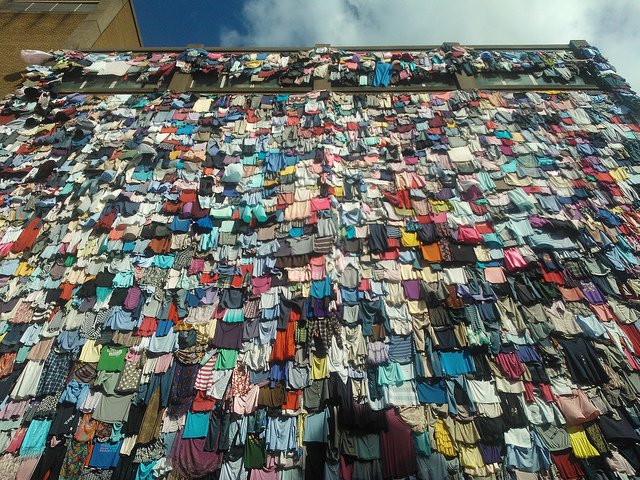Recycling Of Used Clothes And Garments As Constructional Materials

Image Source: Flickr - On Clothes On Building
As much as it seems almost insignificant, unwanted or old clothes disposal is actually contributing massively to the environmental waste menace experienced globally. The poor waste disposal attitude of the majority of the populace even extend to that of clothing and this is quite understandable.
However, the majority of the clothes we dispose of end up in landfills. In fact, more than 90% of the clothes we condemn to trash do actually end up in landfills. And while it would have been good news that they eventually decompose overtime, however, the product of their decomposition is worse than they occupying space.
One may wonder how many clothes actually end up in landfills. Well, according to a report, about 15.1 million tons of clothes and textiles end up in landfills in the United States only.
That is a massive amount of clothes!
However, what if these clothes, when recycled, can be useful as raw materials for other processes thus saving the need to dump them in landfills and saving the environment altogether from their negative impact.
Well, it turns out that old and undesirable clothes can be useful as building materials in construction industry afterall.
Old Clothes As Construction Materials.
Old and undesirable garments can now be changed over into fire and water resistant building materials as opposed to them ending up in landfills and dumpsites. This is achieved by shredding the fabrics into pieces before compressing them into solid boards and flat panels.
The present day's amount of clothes that goes into waste is quite alarming particularly due to the brief period fashion trends exist. Thus, close to of shabby garments and brief form patterns imply that most pieces of clothing are tossed out after a couple of seasons, producing 10 million tons of landfill in the only us every year. As they continuously disintegrate, they discharge lethal synthetics and ozone-depleting substances.
To make new building materials, a group of researchers from the University of New South Wales in Australia gathered a collection of clothing from charity receptacles. After physically removing the zippers, catches, clasps and other strong bits, they passed the extra blend of cotton, polyester, nylon and different textures through a fine-grained shredder.
They, at that point, treated the subsequent wool with a chemical substance to help the distinctive fiber segments stick together. They then packed it under heat to form strong panels.
From numerous tests carried out on the boards, they proved to be strong, water-safe and insignificantly combustible (i.e fire resistant). Their properties could likewise be adjusted by blending the downy with other waste items like sawdust filler from old lounge chairs.
The boards had distinctive surfaces and hues taking after wood or stone, which in turn depends on their blend of parts — making them appropriate for use as floor tiles, divider boards or other interior finishes, says the head of the research team, Sahajwalla. Their quality could likewise make them appropriate for load-bearing applications.
The group is presently fabricating a little industrial facility in the storm cellar of their college working to check whether this recycling procedure which utilises clothings for building materials can be scaled up and popularized.
However, one challenge they seem to confront is the way to change over blends of various garments into building materials with steady properties. “It might just be a case of needing to mix in more of a particular component if you want to adjust the properties,” says Professor Veena Sahajwalla.
This group of researchers headed by Sahajwalla is the first to transform old garments into strong building materials, however analysts in Europe are likewise dealing with reusing them into delicate mats for use as heat and noise insulator inside floors, dividers and roofs.

Old Clothes In Trash - Huffignton Post
Textile fibre waste bindered with natural hydraulic lime - ScienceDirect
How Clothing Recycling Works - The Balance Small Business

If you write STEM (Science, Technology, Engineering, and Mathematics) related posts, consider joining #steemSTEM on steemit chat or discord here. If you are from Nigeria, you may want to include the #stemng tag in your post. You can visit this blog by @stemng for more details.





Hello! I find your post valuable for the wafrica community! Thanks for the great post! We encourage and support quality contents and projects from the West African region.
Do you have a suggestion, concern or want to appear as a guest author on WAfrica, join our discord server and discuss with a member of our curation team.
Don't forget to join us every Sunday by 20:30GMT for our Sunday WAFRO party on our discord channel. Thank you.
This post has been voted on by the SteemSTEM curation team and voting trail in collaboration with @curie.
If you appreciate the work we are doing then consider voting both projects for witness by selecting stem.witness and curie!
For additional information please join us on the SteemSTEM discord and to get to know the rest of the community!